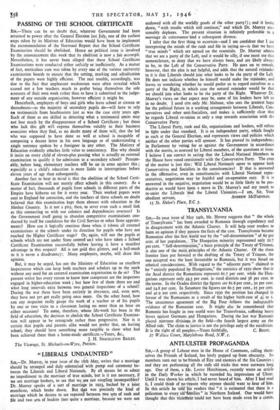TRANSYLVANIA Sm,—In your issue of May 24th, Mr. Hevesy suggests
that" the whole of Transylvania" has been awarded to Rumania through expediency and in disagreement with the Atlantic Charter. It will help your readers to form an opinion if they possess the facts of the case. Transylvania became Rumanian after the first world war by the "self-determination " of 69 per cent. of her population. ,The Hungarian minority represented only 20.7 per cent. " Self-determipation," a basic principle of the Treaty of-Trianon, is also one of the main principles of the Atlantic Charter. Of the three frontier lines put forward at the drafting of the Treaty of Trianon, the one accepted was the least favourable to Rumania, but it was based on ethnical considerations. ,With regard to the "adjacent parts" claimed to be "entirely populated by Hungarians," the statistics of 1930 show that in the Arad district the Rumanians represent 61.7 per cent, while the Hun- garians represent only g9.5 per cent, in rural districts and 38 per cent. in the towns. In the Oradea district the figures are 61.6 per cent., 30 per cent. and 54.8 per cent. In Satumare the figures are 60.5 per cent., 25 per cent and 41.9 per Cent. respectively. Since 1930 the position has changed in favour of the Rumanians as a result of the higher birth-rate of 4 to I. The unanimous agreement of the Big Four 'follows the indisputable evidence of the Rumanian case. It might also be remembered that Rumania has fought in two world wars for Transylvania, suffering heavy losses against Germans and Hungarians. During the last war Rumania placed nineteen divisions in the field—the fourth largest army on the Allied side. The claim to justice is not the privilege only of the recidivists.
It is the right of all peoples.—Yours faithfully, C. Bum. 27 Wallace Court, Marylebone Road, N.W.






























 Previous page
Previous page